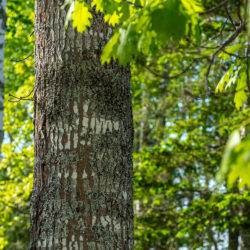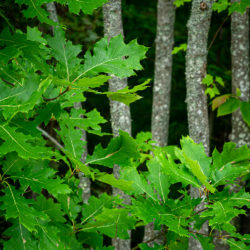Etymology
Quercus is the classical Latin name for oak trees; rubra is Latin for red.
Native Habitat
Mesic slopes and well-drained uplands.
Garden Uses
This tree can be used as a specimen, shade or street tree. It transplants easily when small, but use care as it develops a tap root. In the open it has a fairly rapid growth rate.
Overview
The red oak is a medium-sized deciduous tree with a rounded to broad-spreading, often irregular crown. Typically it grows at a moderate-to-fast rate to a height of 50-75' (often larger in the wild). It is easily grown in average, dry to medium moisture, acidic soil in full sun. It grows best in fertile, sandy, finely-textured soils with good drainage.
Leaves and Stems
This tree has dark, lustrous green leaves (grayish-white beneath) with 7 to 11 toothed lobes that are sharply pointed at the tips. The leaves turn brownish-red in autumn. Its straight trunk is clear of branches for some distance above the ground and supports a wide canopy, commonly 3/4 that of its height. The dark bark is striped with long, smooth plates separated by deep furrows.
Flowers
Insignificant flowers in separate male and female catkins appear in spring.
Fruit/Seed
The fruits are acorns (with flat, saucer-shaped cups), which mature in early fall and are biennial. An abundant crop of acorns may not occur before this tree reaches 40 years old.
Wildlife Associates
Over 900 species of Lepidoptera (most of them moths) use oaks— there is no other genus that comes close to that. The red oak attracts songbirds, ground birds and mammals and is the larval host for the Gray Hairstreak butterfly (Strymon melinus).
Propagation
Propagate from seed. Stratify the seeds or plant them immediately after collecting them.
Ethnobotanical Uses
The northernmost eastern red oak is the most important lumber species of the red oak group and is used for flooring, furniture, millwork, railroad cross-ties, mine timbers, fence posts, pilings and pulpwood.
Garden Location
Staff Entry Garden, West Woods (see garden map)
Sources
Lady Bird Johnson Wildflower Center
Plant Profile by Kathy Kling


